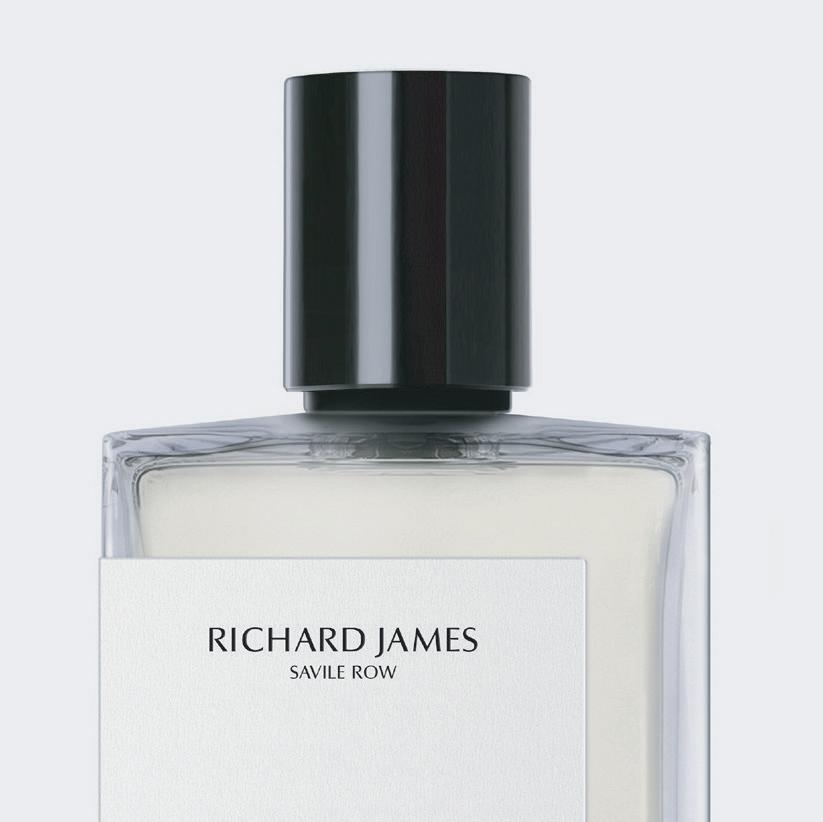
52 minute read
SHOW BOATS
SUNNY SIDE UP The sundeck of the 200foot Andiamo, built by Benetti Yachts with an interior designed by Patrick Knowles.
“For our clients, it is no longer about showing off but about creating luxurious, and, above all, functional environments for their families, who are more active and driven by the spirit of adventure than in the past,” says Miami-based designer Luiz de Basto, who has noticed a distinct downward shift in the age of his patrons. “Many are second-generation yacht owners who come to me with clear notions of what they want and are willing to shell out upward of $100 million to design the vessel of their dreams.”
Advertisement

Having served as lead aesthete in the design and construction of more than 250 yachts over the past three decades, de Basto is keenly aware of even the slightest sea change when it comes to market demand and has garnered a reputation for his quick embrace of major advances in shipbuilding materials and technologies, including app-controlled appliances and navigation. Among the most important of these from a design perspective, he says, has been in the realm of “compound curvature glass,” which can be readily integrated into a vessel’s superstructure, affording near panoramic views of the seascape outside. “With nature taking center stage, our clients are able to enjoy a full-on ocean experience that was unthinkable even a decade ago.”
For his largest commissions—yachts greater than 100 feet in length—de Basto has partnered with yacht yards in Italy, Germany, and the Netherlands, as American builders have, much to his chagrin, largely ceded construction of vessels of such size to their European counterparts. Among his recent projects: the design of the exterior of the 295-foot Dar, which included an unprecedented 4,198 square feet of glass, in collaboration with the Dutch firm Oceanco.
“Once regarded as elite escapes for seasonal sojourns, motor yachts are coming to serve as second homes on the high seas and, in the case of mega-yachts and super-yachts, islands unto them-
TOTAL TRANSFORMATION The Marty Lowe-designed aft deck of the Sanlorenzo 52Steel Seven Sins, above and opposite, serves both as a lounge space and a floodable bay to shelter the shipowner’s tender beneath a main deck pool.
THE PANDEMIC HAS LED SOME CLIENTS TO


selves with resort-style amenities commonly associated with high-end hideaways,” says de Basto.
Fort Lauderdale-based designer Patrick Knowles concurs. “Over the past year, we have seen a dramatic increase in clients asking for yachts designed for long-term living with enhanced wellness and workout spaces, as well as areas specifically designed for children and family members of all ages, not to mention additional storage for longer expeditions. Unless you’ve spent an extended amount of time aboard even the most well-appointed yachts, you wouldn’t notice that such changes were needed. Our clients clearly do.”
In addition to spurring increased demand for spaces dedicated to health and wellness, de Basto adds, the pandemic has also led some clients to request the build-out of full-service medical clinics and places for self-quarantine.
Fort Lauderdale–based designer Marty Lowe says clients are also looking to maximize onboard spaces, eschewing formal dining rooms, for example, in favor of open-plan kitchens and eating and living areas that can double as movie theaters. But, she says, this has also entailed the expansion and enhancement of crew quarters and the utilization of spaces that once had a more industrial function.
For a recent commission, the design of the 52Steel Seven Sins, which cost $35 million and was undertaken by the Italian shipyard Sanlorenzo, Lowe radically reimagined the design of the ship’s transom—converting an aft deck area that historically would have served as a stowage space for marine toys like jet-skis, windsurfers, and runabouts into a so-called beach club—a light-filled lounge area beneath a glass-bottomed swimming pool on the main deck. With the push of a button, a quartet of jackscrews lift the center section of the space, converting it into a floodable bay to shelter the shipowner’s tender.
“Our clients are staying at sea longer, and as a result are requiring more versatile spaces,” says Lowe. “This is pushing us to rethink the whole yacht-owning experience, ushering in a new era of luxury living on the high seas.”

GLASS ACT The exterior of the 295-foot Dar, shown above with her tender, was designed by Luiz de Basto in collaboration with the Dutch firm Oceanco and utilizes an unprecedented 4,198 square feet of glass. Top left: The glass-enclosed interior of the 295-foot Cosmos, another de Basto/Oceanco collaboration.


MARTY LOWE, YACHT DESIGNER
LIVING

FANTASY ISLAND

For the ultra-elite, Palm Beach is a 16-mile slice of heaven on Earth. Liz Petoniak explores an American paradise where status and sunshine meet for drinks
PINK HOUSES The love child of a golf cart and a stretch limousine awaits you outside the Colony Hotel; above: nobody wears sweatpants to walk the dog in this town.
In its more than 100 years of providing a tropical respite to the nation’s richest families, Palm Beach has never been more relevant.
The forty-fifth president of the United States, of course, attracted the world’s attention to the island. But other factors, like the high concentration of billionaires who call it home, and a mass migration from the Northeast only accelerated by Covid-19, have also highlighted the 16-mile-long barrier island’s natural beauty, glittering wealth, cultural amenities, and the relaxed lifestyle such an environment affords.
Palm Beach’s monied tradition began in 1892 with the arrival of oil and railroad tycoon Henry
Morrison Flagler, who first saw the potential in the sparsely inhabited island. Shortly thereafter, he raised the Royal Poinciana and the Palm Beach
Inn, the latter of which would eventually become a little resort called the Breakers. Flagler also constructed the Florida East Coast Railway and the
Over-Sea Railroad, a rail line running from Jacksonville to Key West that transported Rockefellers,
Vanderbilts, Astors, and the likes of J. P. Morgan,
Andrew Carnegie, and William Randolph Hearst to his luxury Palm Beach resorts. Concurrently, the industrialist built his own Beaux Arts mansion on the island, Whitehall, which now offers visitors a glimpse into the glamour of the so-called Gilded Age as the Flagler Museum.
The Breakers was so hot that it burned to the ground, twice: once in 1903 and again in 1925. Determined to create the world’s preeminent resort following the second fire, Flagler’s heirs enlisted architectural firm Schultze and Weaver to raise a magnificent, Italian Renaissance-style hotel. The circa-1926 building, with its 200-foot-long lobby, significant for its hand-painted ceilings and Venetian glass chandeliers, is still regarded as Palm Beach’s undisputed crown jewel. But the hotel is not content to rest on its laurels: like the grande dames it serves, it is constantly, if discreetly, having work done.
In the 1960s, Palm Beach became the winter home to President John F. Kennedy, Jackie Kennedy, and the First Lady’s collection of Lilly Pulitzer shift dresses. Peanut Island, just off the North End of Palm Beach, remains the site of the former president’s nuclear bunker. Now, it serves as a 79-acre public park that attracts boaters and snorkelers.
Even in the twenty-first century, Palm Beach persists as a beacon of old-world quality and qualities. Its European charm is evident at landmarks such as Worth Avenue, the town’s com-
mercial center lined with elegant shops, Addison Mizner’s Spanish Revival architecture, and Mediterranean vias that reveal hidden courtyards. Rolls-Royces are often referred to as the “Palm Beach Mercedes,” and the “Season” (in normal times) consists of an endless string of galas that raise millions upon millions for local and national charities. Even the Publix grocery store resembles a Mizner mansion and boasts valet service. As a local billionaire’s wife once said to me, “It’s a very civilized place, isn’t it?” Palm Beach often feels like an impermeable safe haven, as if nothing rotten could possibly touch it. Though we know that’s far from the truth—ahem, do the names Epstein and Madoff ring a bell?—it’s easy to forget humanity is facing a global pandemic when you’re watching the waves curl and crash at Flagpole Beach. And, because distractions are plentiful, it’s possible to put our nation’s unrest out of mind—until you drive past Mar-a-Lago or bump into the Secret Service, that is.
No doubt, this escapism adds to the island’s allure. However, Palm Beach isn’t the same vacation destination your grandmother remembers. The privacy and privilege that comes with the 33480 ZIP code now also comes with upgraded amenities and a refreshed, youthful energy thanks to new investment—such as the revitalization of Royal Poinciana Way into the main street that Flagler envisioned—and the demands of a younger population. Couples with children in their 30s and 40s, who grew up visiting the area, are now making Palm Beach their own.
Behind the impeccably manicured hedges, Palm Beach is ultimately a small beach town where thirtysomething entrepreneurs, young families, and those in their golden years exist in harmony.
As such, stiff formality has given way to a more laid-back sophistication. You certainly won’t see white tablecloths or stereotypical pearl clutching at Buccan or Imoto, the island’s two reigning hot spots run by James Beard Award nominee Clay Conley. But you will find Chanel bags paired with denim and a local IPA on the same table as steak tartare with black truffle and a crispy cured egg yolk.
Beginning in 2011 with the opening of Conley’s restaurants, Palm Beach’s food scene has served to elevate the island’s cachet. In 2019, Mauro Colagreco, the three-Michelin star chef who helms the top-rated Mirazur in France, put his name behind Florie’s at the recently renovated Four Seasons Resort Palm Beach. Daniel Boulud’s Café Boulud has been a longtime island resident, and as Northeasterners flee south, many of the restaurants they frequent, such as Upper East Side favorites like La Goulue and Le Bilboquet and the Hamptons’ beloved Almond, have followed.
“What I love about Palm Beach today is that there’s still a nod to tradition and to the Old World—jackets, great shoes, pretty dresses,” says Eric Lemonides, restaurateur and owner of Almond. “The only difference now is that there’s a little more fun involved.”

PARADISE CITY Clockwise from opposite: A seagull’s view of the Breakers Palm Beach; en pointe at the Royal Poinciana Plaza; and a Mizner masterpiece on Worth Avenue.

LOLA 41 AND THE WHITE ELEPHANT HOTEL
Working in Palm Beach in the ’90s, restaurateur Marco Coelho remembers the days when there were only a handful of places to eat on the island. “It was all the same food,” he laments. “For something different, you had to cross the bridge.” Today, the PB location of his Nantucket restaurant LoLa 41 allows diners to cross continents without ever leaving its sultry lounge or intimate courtyard with towering poké “nachos,” decadent burgers with foie gras sauce, and expertly prepared sushi. LoLa anchors the White Elephant Hotel—another Nantucket-based newcomer— inside of a whitewashed Mediterranean revival where the defunct Bradley Park Hotel once stood. With the most contemporary furnishings and artwork of any lodging in Palm Beach to date, the White Elephant is a breath of fresh air.
THE ROYAL POINCIANA PLAZA
Recent renovations and new tenants like Hermès, Oscar de la Renta, Kirna Zabête, Zimmerman, and LoveShackFancy have restored architect John Volk’s 1950s outdoor plaza into a hip shopping mecca and community gathering space for Palm Beach’s next generation. Make a day of it and visit public art exhibits from Pace Gallery, renowned for its contemporary collections worldwide, and Acquavella, a noted Upper East Side gallery that opens its first location outside Manhattan this season. Then, be sure to refuel with the crispy chicken sandwich at the Hillstone Restaurant Group outpost Honor Bar; Mexican street food and spicy margaritas at Coyo Taco, a favorite of Miami’s Wynwood neighborhood; or the divine strawberry gelato from that purveyor of all things Italian and delicious, Sant Ambroeus.
HENRY’S PALM BEACH
Everything the Breakers touches turns to gold, and Henry’s is no exception. The resort’s newest restaurant, located on Royal Poinciana Way, perfects the art of comfort food, elevating appetizers like pigs in pretzel dough blankets with Pilsner fondue, and serving true luxuries like stone crab claws and butter crumb Dover sole. An approachable yet posh interior designed by Adam Tihany and over-the-top touches like the leather-backed menus monogrammed with Henry M. Flagler’s initials—truly, they could be mistaken for a Goyard clutch—go a long way with well-heeled Palm Beachers.
GREENMARKET
Pop over the bridge to visit the waterfront farmers market frequented by Dr. Oz and Martha Stewart. Located downtown with the Intracoastal as its backdrop, the West Palm Beach GreenMarket greets visitors with mimosas, the smell of cider doughnuts wafting in the air, and incredible dog watching. Discover the some of best croissants outside of France from Loïc Bakery and impressive single-origin brews from Pumphouse Coffee Roasters while shopping for the week’s necessities: greens from Swank Specialty Produce, a fresh loaf from Bread by Johnny, and artisanal cheeses from La Montagne Des Saveurs.
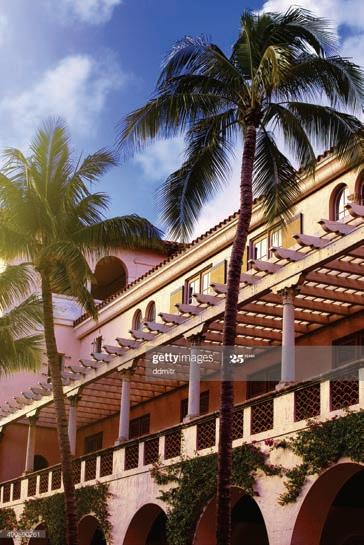
WALK THIS WAY Clockwise from right: The welcoming Society of the Four Arts; Claes Oldenburg’s Typewriter Eraser, Scale X at the Norton Museum of Art; footloose and fancy (but not free) slippers from Stubbs & Wootton.
SOCIETY OF THE FOUR ARTS
Beautiful days in Palm Beach start with a bike or walk along the Lake Trail, visiting the nearly 200-year-old giant kapok tree, and ending at the island’s cultural hub—the Society of the Four Arts. Stroll through the tranquil gardens, where you’ll discover a sculpture garden, tropical flora and fauna, and an installation from master glass artist Dale Chihuly arriving this spring. Or, venture indoors to attend a lecture, workshop, book discussion, concert, or exhibit. This season’s remarkable lineup includes the “Charles and Jackson Pollock” exhibit, which will showcase 70 paintings and works on paper from Charles, the “elder Pollock,” as well as a selection of Jackson’s rarely seen works, from January 30 to March 28.
STUBBS & WOOTTON
Whether sporting a tuxedo at a charity gala, a sundress at brunch, or a bathrobe while quarantining at home, handmade smoking slippers in velvet, needlepoint, or raffia are required footwear in Palm Beach. Founded on the island in 1993, Stubbs & Wootton allows shoe lovers to create their own bespoke pair at its Worth Avenue location.
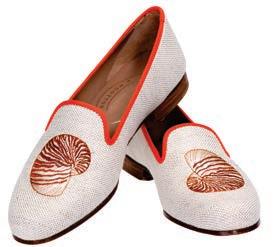
RAPTIS RARE BOOKS

Just down the avenue, New England transplants Adrienne and Matthew Raptis share their love for reading, history, collecting, and travel with the local bibliophile community at their antique bookshop and firm. “Palm Beach has a unique cachet and population,” says Adrienne. “We enjoy seeing people who appreciate arts and literature face-to-face.” Inspired by some of the couple’s favorite European libraries, the brick and mortar’s stately bookshelves house everything from a first edition of The Great Gatsby to handwritten Isaac Newton manuscripts, to a collection of original
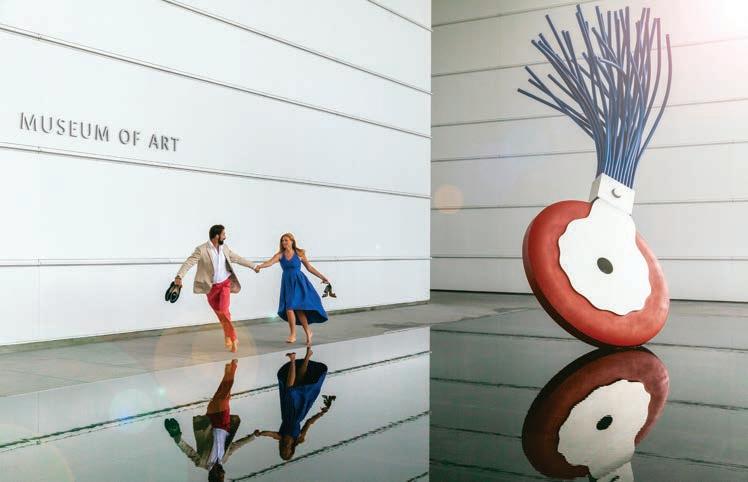
Harper Lee drawings and letters.
NORTON MUSEUM OF ART
Worth venturing over the bridge to see, the Norton will celebrate its 80th anniversary this year. Founded in 1941 by two art collectors, Chicago-born industrialist Ralph Hubbard Norton and his wife, Elizabeth Calhoun Norton, the museum has become a must-visit arts destination for its contemporary collections and work highlighting emerging mid-career artists. In 2019, a $100 million renovation led by famed architect Lord Norman Foster added 12,000 feet in gallery space and a striking entrance wrapping around a banyan tree. This year’s provocative exhibits address issues surrounding immigration and racial injustice.
PALM BEACH OPERA
Palm Beach’s professional opera company returns this season with its first-ever festival from February 19–27 at the outdoor iTHINK Financial Amphitheatre at the South Florida Fairgrounds. The opera will stage three popular pieces in a concert and semi-staged format: La Bohème, a romance set in 1830s Paris; Pagliacci, a tragic love-triangle tale; and Mozart’s family-friendly Die Zauberflöte. Seats at the open-air, covered venue will be socially distanced, sanitized, and filled to only 30 percent capacity. Audiences can expect to hear some of the art’s top performers. “It’s turning out to be a veritable who’s who of the opera world,” says general director David Walker. “It will be an artistic experience that we hope will deliver healing, hope, and excitement.”
THE COLONY HOTEL
This landmarked property is a modern-day Slim Aarons paradise. Since purchasing the Colony in 2016, CEO Sarah Wetenhall and her husband, Andrew, have lovingly infused the boutique hotel with their playful flair. Under the Wetenhalls’ watch, the former Polo Lounge was transformed into the bright and airy CPB, a restaurant led by chef Tom Whitaker that infuses Floridian fare with his British sensibility—something the Duke and Duchess of Windsor would have likely appreciated during their frequent stays way back when. Last season brought a well-received popup of Upper East Side icon Swifty’s to the Colony, which will extend this year into Swifty’s POOL for alfresco cocktails, dinner, and lunch beneath the hanging poolside garden. Finally, the arrival of Bluestone Lane will offer guests both grab-andgo and sit-down options for breakfast and lunch.
ALMOND
When restaurateur Eric Lemonides and chef Jason Weiner opened Almond’s third location in the former Nick & Johnnie’s space last year, the moody bistro with cozy booths and orange Scalamandré zebra wallpaper quickly became a neighborhood staple. Here, you’re bound to bump into friends and old acquaintances who share the same sentiment about Lemonides’s unfussy approach. “This is the nightclub for my age group,” says Lemonides. “People like me who grew up in the ’80s and ’90s still want sexy music and a great atmosphere, but we can’t party like we used to. Instead, we want to drink a nice bottle of wine and enjoy a proper dinner.” Almond’s menu is familiar, but interesting enough for a night on the town. The Brussels sprouts Caesar has a cult following, likewise the pork Milanese and halal cart-inspired roast lamb. It all showcases produce from the local farming community, just as the partners aim to do at their Bridgehampton and Manhattan locations. “We all want informality,” he says. “But everything still has to be perfect.”
ERIC LEMONIDES, ALMOND RESTAURATEUR
UNDER MY UMBRELLA Colony Club kids relax during mocktail hour.


PALM BEACHED: THE BOARD GAME


EVERYONE KNOWS THIS IS A BARRIER ISLAND IN MORE WAYS THAN ONE. SO IF YOU WANT TO WIN THE GAME, YOU HAVE BE ABLE TO TELL A FANJUL FROM A LAUDER AND A PITT FROM A PHIPPS. YOU ALSO HAVE TO KNOW WHERE TO BE SEEN. BY BOB MORRIS ILLUSTRATED BY TRACY DOCKRAY

NICK MELE, THE NEXT SLIM AARONS, SNAPS YOUR PICTURE
ASK A SOCIALITE OF A CERTAIN AGE IF THE BLOWDRIED ESCORT ON HER ARM IS HER GRANDSON COSMETIC SURGERY MISHAP
PLAYERS

TRUMP MOTORCADE MAKES YOU LATE FOR COCKTAILS AT TOMMY QUICK’S HOUSE

PHOTOGRAPHED WITH GEORGE HAMILTON AND KRYSTIAN VON SPEIDEL FOR THE PALM BEACH POST
MEET COLONY HOTEL PRESIDENT SARAH PRESIDENT SARAH ORDER THE PATTY MELT METENTHALL AT TRIVIA METENTHALL AT TRIVIA AND COFFEE MILKSHAKE NIGHT NIGHT AT GREEN’S


START

MARRY INTO A MEMBERSHIP AT THE BATH AND TENNIS
BREAK A MOSER BUD VASE WHILE BROWSING AT MCMAKIN AND KEMBLE
EACH SOCIAL MOVE IS A ROLL OF THE DICE IN THIS PLAYGROUND OF PLUTOCRATS, AND YOU HAVE TO KNOW THEIR RULES BEFORE YOU CAN BREAK THEM. ADVANCE A SPACE WHEN YOU LAND ON A GREEN ARROW AND SLIDE BACK FOR EVERY RED ONE.



ATTEND DINNER AT SANT AMBROEUS AFTER SARAH GAVLAK OPENING
THE SOUTHERN BRIDGE MAKES YOU LATE FOR BRIDGE YOUR DATE GETS INTO A CATFIGHT AT THE LEOPARD LOUNGE

YOUR GAY MARRIAGE PERFORMED BY FATHER BURL AT BETHESDA-BY-THE-SEA BITSY MARSHMAN LIKES YOUR FERRAGAMO BALLET FLATS

MEET COLONY HOTEL
PRESIDENT SARAH PRESIDENT SARAH
METENTHALL AT TRIVIA METENTHALL AT TRIVIA VALET NIGHT NIGHTDELAY AT LE BILBOQUET
MEET COLONY HOTEL PRESIDENT SARAH WETENHALL AT TRIVIA NIGHT MEET COLONY HOTEL MEET COLONY HOTEL
PRESIDENT SARAH PRESIDENT SARAH METENTHALL AT TRIVIA METENTHALL AT TRIVIA NIGHT NIGHT


BURN ROOF OF MOUTH ON A CHEESE PUFF AT CLUB COLETTE

RECEPTION AT BETH RUDIN DEWOODY’S BUNKER; COLE RUMBOUGH SINGS
BUY A MEGAYACHT TOO BIG FOR THE TOWN MARINA YOUR STARCHITECT’S PLAN APPROVED BY ARCOM, THE ARCHITECTURAL GESTAPO

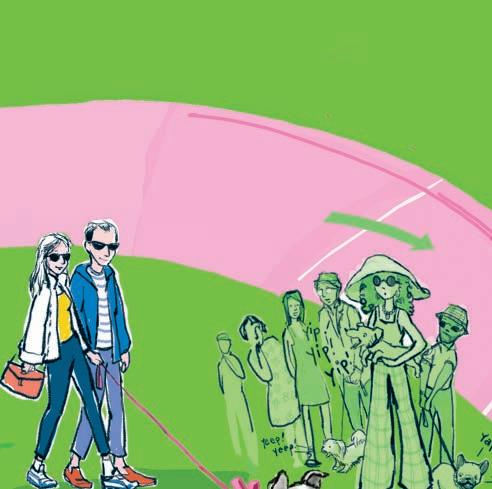
YOU GET AMANDA LINDROTH TO DECORATE YOUR INTERIOR

YOUR HOUSE ON JUNGLE ROAD WINS THE BALLINGER AWARD FOR PRESERVATION
ASK “WHAT IS TOMATO ASPIC?” ON THE CAFETERIA LINE OF THE BATH AND TENNIS COCKTAILS AT THE KESSLERS’ CASA BENDITA




HURRICANE DESTROYS YOUR BEACHFRONT HOME ON SOUTH OCEAN BOULEVARD

UNCOVER A VINTAGE LILLY AT THE CHURCH MOUSE
FALL OFF YOUR TAMARA MELLONS AT BUCCAN AFTER FOURTH NEGRONI

MISS THE CHOCOLATE BABKA AT PALM BEACH COUNTRY CLUB DESSERT BUFFET
RETURN TO THE SAILFISH CLUB MARINA WITH A 100-POUND BLUEFIN TUNA AND A TAN.



WEAR CULT GAIA BIKINI AT EVERGLADES CLUB, BREAKING REVEALING SWIMWEAR BAN

GET MENTIONED IN SHANNON DONNELLY’S SHINY SHEET COLUMN


THE FANJULS INCLUDE YOU ON THEIR HOLIDAY “CARD” NOTABLES LIST

YOU’VE ARRIVED

THE SPLENDID CITY
In 1925, the architect and city planner Addison Mizner started work on Boca Raton, which he called “the dream city of the western world” and its “new social capital.” Ninety-six years on, Alyssa Fisher sees how it’s going

ADDISON AVENUE Left: The welcoming waters of the Atlantic. Above: The Boca Raton Resort & Club, designed by Addison Mizner, is the city’s most famous building.
At the beginning of the 20th century, the settlement of Boca Ratone (as it was then spelled) was little more than a picturesque string of farms, whose 100 residents made a living coaxing pineapples out of the sandy soil.
But the 1920s ushered in a South Florida land boom, and with it came a literal bridge to the future. Early that decade, the first fixed-span bridge over the town’s inlet connected it to a coastal highway, which brought in a steady stream of vacationers and prospective land buyers. By 1925, the council of the newly incorporated town of Boca Raton had enlisted prominent local architect Addison Mizner—known for his “Mizner Mediterranean” pastiche of Spanish and Latin American styles—to create “the foremost resort city on the North American continent.”
A prospectus published by the Mizner Development Corporation that year (which described its boss as doing “more than any other one man to make Palm Beach beautiful”) announced that Boca Raton would be “a resort as splendid in its entirety as Palm Beach is in spots.” In that hopeful pronouncement, the modern Boca Raton—a bridesmaid to its elder and richer sister city 27 miles up the coast—was born.
The architect went quickly to work, setting the tone with his monastic coral stone Ritz-Carlton Cloister Inn in 1926—now the Boca Raton Resort & Club—which remains a city landmark. His vision of manicured lawns and gated neighborhoods alongside abundant golf courses and parks still defines the city’s ambience.
Beyond its looks, however, Boca Raton also has a brain. Attracted by a favorable business environment, IBM arrived in 1967 (its first personal computer was invented here in 1981), and many followed. Today, the city hosts more than 200 companies and about 40 corporate and regional headquarters, including ADT, Office Depot, and Modernizing Medicine—swelling the population to roughly 100,000 and growing.
“We have the charm, natural beauty, and elegance of a smaller city and the strong business presence and cultural offerings of a much larger city,” Mayor Scott Singer tells Avenue. “In business and vibrancy, we punch above our weight.”


Singer, a lawyer, grew up 30 miles south in Fort Lauderdale. After graduating from Harvard University and living in Manhattan, where he met his wife, Bella, the couple moved to Boca in 2011.“This was the place we chose to raise our children,” he says.
The city’s amenities were especially appreciated by its residents during Covid-19, says Cristy Stewart-Harfmann, president of the Junior League of Boca Raton, a leading local philanthropy. Not only did she already have a family who love aquatic activities, but she also welcomed a second child during the pandemic.
“We are in the water basically any time we’re outside. We’re in the pool, at the beach, on the boat,” she says. “You can still be socially distanced but be together and be outdoors. It’s just glorious. It’s hard to think about living anywhere else.”
It all sounds lovely—but is there any rivalry with the city’s bigger and more glamorous sister up the coast?
“Palm Beach is great, for what it is,” allows Mayor Singer. “They also have a financial services presence, along with their beaches, as well as the Mizneresque shops and eateries. We have all that, and with a far stronger business presence, three universities, grade A schools for all ages of students, 47 parks, and much more.”
And another Boca benefit? “Palm Beachers need to leave their city limits to experience the offerings in West Palm Beach, while our residents can learn, work, live, and play within our borders,” he adds.
Almost exactly a century on from that game-changing bridge, Boca is still investing in transport infrastructure. In addition to a recent upgrade of customs facilities that will allow for international passengers at its airport, a railway station connecting the city to South Florida’s high-speed Brightline network is planned to open in 2022.
“Home values increased and supply has dwindled, as people are coming here as a safe haven from some of the unfortunatel challenges that other cities are facing,” Mayor Singer says. “When you can work from home anywhere, why would you not want to be working in paradise?”
In fact, Mizner made exactly the same point in 1925. “Boca Raton recognizes no competition in its claim upon your consideration” reads his prospectus. “There is no substitute for Boca Raton.”
Boca has more than 1,600 acres of recreational space, much of it downtown. “It’s a great destination for its walkability,” said Ruby Childers, Boca Raton Downtown manager. “A one-stop shop, anything you want and more.” She recommends strolling through its lush green spaces, such as Sanborn Square, enjoying the omnipresent fountains, gazebos, and Spanish-Mediterranean architecture. Plans to revitalize the downtown waterfront are in the works, Singer said. Wildflower and Silver Palm Park will be combined into a new six-acre site, with a wide pedestrian promenade, boat launches (public beaches are about 1.5 miles away), and plenty of space to gather.
ADDISON MIZNER, 1925

ALL YOU CAN EAT
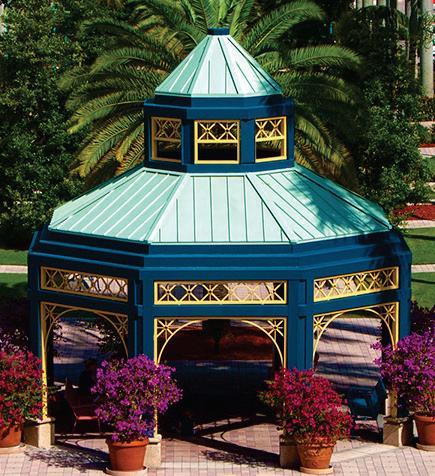
Dining is one of Downtown’s most popular attractions, with nearly 100 restaurants, spanning dozens of cuisines. “The food is all amazing, I try to make the rounds,” Childers says. She recommends downloading its new self-guided walking tour, The Food Lover’s Trail, to experience it all. Alfresco dining is widely available, but with so many parks and public green spaces to picnic in, many restaurants also offer to-go packages, including the option of a bottle of wine. Mayor Singer points to a classic local favorite Max’s Grille as one of his favorite spots, and other notto-miss eateries include Fries to Caviar, Farmer’s Table, Arturo’s Ristorante, New York Prime, Boca Landing, Louie Bossi, and Six Tables a Restaurant.
MIZNER PARK
A highlight of downtown, Mizner Park epitomizes the Spanish-influenced vision of its namesake architect. Its park-like plaza features a mix of elegant boutiques and restaurants. The amphitheater hosts socially distanced performing arts events, including concerts and comedy and magic shows. More shopping can be throughout downtown Boca, as well as in Town Center at Boca Raton, Boca Center, and Royal Palm Place.
ART AL FRESCO Clockwise from opposite: Marty’s Cube (1983) by Tony Rosenthal, sibling to the one in Manhattan’s Astor Place, is installed at the Boca Raton Museum of Art; a shady spot in Mizner Park; the garden terrace of Farmer’s Table.
BOCA RATON MUSEUM OF ART
Mizner Park is also home to the Boca Raton Museum of Art, founded more than 70 years ago. In addition to seasonal exhibitions by American and international artists, works by Andy Warhol, Edgar Degas, Pablo Picasso, and Henri Matisse are in its permanent collection. Glasstress Boca Raton II, an exhibition of glass pieces by more than 30 international artists; paintings by Paul Gervais; and a collection of Florida Outsider art will be on display beginning January 26. There are two sculpture gardens featuring more than 30 works, which can be found around the museum’s building and in the two-acre garden at the Boca Raton Museum Art School.
TEE TIME
There are 34 golf courses throughout the city, including the historic Boca Raton Resort & Club, a Waldorf Astoria Resort, which hosts a championship golf course with 36 holes. When it sold in 2019 to billionaire businessman Michael Dell for an astounding $875 million, Forbes declared it the largest real estate transaction in Palm Beach County history. His group plans to invest $150 million more into the 95-year-old resort. “That’s really going to transform it, that’s an essential driver to tourism, for business,” Singer says. The property announced it would donate the 130-acre Boca Country Club to become a city-owned and operated facility by this October, featuring an 18-hole championship course, clubhouse, tennis courts, and pool. Other public courses of note include the Osprey Point Golf Course, which has 27 holes spread out in three nine-hole courses on a Platinum Paspalum turf; Southwinds Golf Course, a certified Audubon International Cooperative Sanctuary, with wildlife including otters, foxes, and iguanas milling around, and the Boca Raton Municipal Golf Course, a public championship course for golfers of every level.
GET TO THE BEACH
Boca Raton sits on five miles of Atlantic coastline. Visitors may swim and picnic at Spanish River Park, snorkel and fish at Red Reef Park, or visit the turtles and other wildlife at nearby Gumbo Limbo Nature Center. South Beach Park is ideal for avid bird watchers, while Lake Boca is a popular inlet for boaters. “We will never take the beach or the parks for granted ever again,” Stewart-Harfmann said. “We stayed here because of all of the amazing things to do. It’s just a wonderful place to raise a family and enjoy the outdoors, pretty much 365 days of the year.”
MANY YOUNGER NEW YORKERS,
UNSETTLED BY CONDITIONS IN THE CITY, HAVE FLED FOR THE COMFORTS OF SOUTH FLORIDA. JOSHUA DAVID STEIN DISCOVERS THAT PALM BEACH AND ITS NEIGHBORING CITIES AREN’T JUST FOR RETIREES ANYMORE
ILLUSTRATIONS BY YANN BASTARD

From Park Avenue To Palm Beach

YAZ HERNÁNDEZ, RECENT ÉMIGRÉ

When Covid-19 hit New York City in early March, Scott Hesse, 39, along with his wife, Whitney, and their baby boy had just settled into their brandnew condo on the Upper West Side. It was the home they had always dreamed of, designed by Sasha Bikoff, who, in a feature in Hamptons Cottages and Home magazine, described the aesthetic of the 2,100-square-foot three-bedroom apartment as “feminine and colorful, with some Hollywood glamour and Chinoiserie accents.”
But soon the family bid their Hermès chandeliers and Deco settees goodbye. Hesse, who works as a data scientist for Amenities Analytics, a financial analytics firm, rented a charming rural house in Delaware to ride out the pandemic. “We booked it for two weeks,” he said, “but ended up staying three months.” Eventually they returned to Manhattan to, as he says, “test the waters.” But they returned to a city humbled and a block, according to Hesse himself, besmirched.
“They had just opened three homeless shelters near our apartment,” complained Hesse, aghast. “It used to smell like urine every fourth block, now it smelled like urine every block.” Hesse knew he had to leave. “Winter was coming,” he said, ominously. “We had to get out.”
Soon the Hesses had joined a massive exodus of the well-heeled from the northeast to the sunny climes of Florida, a population shift made possible by the dissolution of the workplace: preferable by this no-goodnik virus, and perfect by Florida’s lack of state income tax, which has turned the state into a palm-shaded neoliberal paradise. According to a report by ISG World’s Miami Report, more than 1,000 arrivals a day are flooding into Florida, many settling on the stretch between West Palm Beach and Miami, the lion’s share of those new arrivals hailing from the Northeast.
According to Kelly Smallridge, president and chief executive of Palm Beach’s Business Development Board, “Covid has really put us on fire.” And whereas the southeastern coast of Florida once had a reputation as an old folks’ home, many of the new folks aren’t ready to shuffle into oblivion. “The age of our new arrivals has come down dramatically,” she says.
“It’s not the waiting room of heaven,” purrs Yaz Hernandez, the former New York City social fixture and current West Palm Beach resident, from her balcony overlooking the Atlantic Ocean, “it is heaven.” In May, Ms. Hernández fled her pad on Park Avenue. Broadway was quiet, restaurants were ghostly, the rain fell sideways, and long nights creaked with loneliness. “I came to Palm Beach for a party and never left.” (The party in question was the 50th birthday of Donald Trump Jr.’s paramour, Kimberly Guilfoyle, at Mar-a-Lago but, letting out a nervous laughter, Hernández says, “Maybe I shouldn’t say that, no ?”) No matter, shortly after arriving, Ms. Hernández rented not one or two but three properties in the area. And though she’s keeping her Park Avenue pad, Ms. Hernández isn’t leaving any time soon. “I love it down here. All of my friends are young and stylish. It has all the energy that’s missing in New York.”
Her neighbor, Felicia Taylor, another recent émigré, says she won’t leave either. A longtime television journalist (and daughter of actor Rod Taylor), she put her Park Avenue condo on the market and moved south in February. “I have quite a few friends who have come down here and bought apartments sight unseen,” says Ms. Taylor. Speaking to Avenue from her terrace—“the first time in my life I have a terrace!”—she wondered why anyone would stay in New York. “With online platforms and technology there’s no need,” she said. “I just finished a documentary: the director was in Lebanon, the editor was in Brooklyn, and I’m here. It worked wonderfully.” Ms. Taylor’s new lifestyle, she says, includes plenty of time spent outside, gazing at palm trees or zipping down the coast in her new white convertible, a circumstance seldom to occur in the tri-state area.
But much of the boom has been driven by big money hedge funds drawn to the laissez-faire regulatory framework of the Sunshine State. Among those who have recently relocated or are planning to move their hedge fund, wealth management, and family offices to Florida are Ken Griffin of Citadel Securities, whose firm rented out the entire Four Seasons in April; Paul Tudor Jones of Tudor Investment Corporation; Paul Singer of Elliott Management; Blackstone; and Michael Dell of MSB Capital, who moved his family to West Palm. When they arrive, many are greeted by Ms. Smallridge, who as the head of the BDB acts as a sort of concierge for high-net-worth individuals. “I have a dog and pony show,” she explains.
Those contemplating the move might start with breakfast at the Breakers, followed by lunch at the yacht club. Maybe the mayor of Palm Beach might meet you, perhaps some state official will drop by; if you have school-age children, Ms. Smallridge might arrange a meeting with the headmasters of local schools like the well-regarded Ransom Everglades or Palm Beach Day. The evening might end eating oysters at Blue Pointe Bar and Grille as the sun sets—and Ms. Smallridge notes that there is as much state income tax in Florida as there is snow. “We’re looking at the weaknesses of Manhattan,” she says, “and taking advantage.”
But of course the influx has been hell for buyers. The market in Florida is, to the say the least, hot. According to figures from ISG, there are only 12,934 single family homes available in Miami-Dade, Broward, and Palm Beach Counties, down from 3,955 in 2019. Only 0.88% of single family home are for sale or rent in Palm Beach County, 0.96% in Broward. and 0.83% in Miami-Dade. Houses that would sell for $5 million in 2019 are today going for treble that amount.
As for the Hesses, they’re still looking to buy. “We’ve responded to a bunch of listings to rent, but by the time we did, they were gone,” complained Mr. Hesse. Luckily, they did find a place in Jupiter. “It’s at the Trump National Golf Club,” says Mr. Hesse, noting its unusual availability. “I don’t know if it’s because of the name or what, but we’re just happy we found somewhere to live.”
TAKE TWO ASPIRIN AND CALL THEM AT 3 A.M. SHIVANI VORA ENTERS THE ELITE WORLD
OF CONCIERGE MEDICINE, WHERE DOCTORS SLEEP WITH THEIR CELL PHONES IN ORDER TO BE ON CALL FOR THEIR WEALTHY PATIENTS TWENTY-FOUR HOURS A DAY
ILLUSTRATIONS BY DEREK ABELLA

Doctors Without Boundaries
It’s an unfortunate truism that money can’t buy health. But, as Hippocrates himself might have noted, it’s also true that it does no harm.
So it’s no surprise that a city like Palm Beach, which seemingly has a billionaire over every fence, has emerged as a world leader in innovative personal healthcare— for those who can afford to pay. For the wealthiest of patients, the new must-have is an on-call, private medical team.
Among this elite group of so-called “concierge doctors,” the names to see include Dr. Bina
Rashid, Dr. Dean Mann, Dr. Bruce Moskowitz, and Dr. Gabriela Goldstein. These professionals charge an annual fee in exchange for making themselves available to their patients 24/7, according to Sharona Hoffman, codirector of the
Law-Medicine Center at Case Western Reserve
University, in Cleveland.
“Patients have their [doctors’] cell phone numbers, and they’re always at the ready to drop all else to tend to them whenever they need. Some even make house calls,” says Hoffman. Physicians respond immediately to everything from pressing concerns like an allergic reaction, a heart attack, or these days Covid-19, to more minor ailments like a cold or a pulled muscle.
Of course, there will always be hypochondriacs. One patient is known for (regularly) mistaking his indigestion for appendicitis. Another accidentally slammed a car door on her young child, diagnosed herself with (nonexistent) Covid and declared the only explanation could be that her reflexes had been diminished by the virus.
Concierge doctors can lavish this kind of attention on each individual because they limit the number of patients they accept. The average medical practice has between 2,000 and 3,000 patients and sees as many as 40 a day; a concierge practice generally takes on only between 200 and 600 and sees fewer than eight.
Naturally, there’s a price for this kind of access, and concierge doctors—like anything else in a marketplace—have their own hierarchy ranging from affordable to elite. Their annual fee can be a palatable $1,800 or an eyebrow-raising $25,000, or more.
At the lower end of the scale, some doctors even accept insurance to help cover their costs of appointments beyond annual physicals. But at the higher end, some patients regard it as a point of honor that they pay out-of-pocket to be attended by experts too rarefied to be covered by insurance plans.
While these doctors have become more common around the country in recent years, says Hoffman, particularly in wealthy areas such as Manhattan’s Upper East Side and Beverly Hills, they seem to have especially taken off in Palm Beach: MDVIP, a national network of more than 1,100 concierge doctors, has 24 affiliates in Palm Beach County, an increase of 33 percent since 2015.
In comparison, most markets grew between 5 and 10 percent during that period, according to MDVIP’s CEO, Bret Jorgensen. “Palm Beach has a lot of demand because of its affluence,” he says. “Concierge doctors are a well-known concept there.”

DR. BINA RASHID
DR. DEAN MANN
Forget any notion that these doctors are hot in Palm Beach because the city’s population is aging. The 2010 Census indicated that more than half the residents were 65 or older, but concierge doctors say their growth area is patients under 50.
Rachel Scher, a 37-year-old Palm Beach Gardens resident, is a prime example. The publicist and her family, including her husband and their two sons, ages 11 and 9, are among the thousands of locals and snowbirds who rely on a concierge doctor for their medical needs. “All of my friends also have one, and people here in general are moving toward using them,” says Scher. “It’s a privilege for sure, but well worth it to us.”
Their doctor, Bina Rashid, founder of Palm Beach Boutique Medicine, started her business in 2019 and has already become one of the most sought-after doctors in town. She also treats several prominent celebrities and polo players.
With a yearly fee ranging from $2,000 to $5,000 depending on the number of family members who join (Scher pays $5,000), plus extra for house calls, Dr. Rashid says that there’s nothing she won’t do to accommodate patients. “I sleep with my cell phone on next to me, and my patients know they can call me any time of day or night,” she says.
Educated at St. Matthew’s Medical School in the Cayman Islands, then in Belize, and with experience that includes several years at both JFK Medical Center and Palms West Hospital, in Loxachatchee, Dr. Rashid, 44, is as stylish as she is competent. Always toting a Chanel or other haute designer bag and dressed in the latest Veronica Beard jacket, even when seeing patients, she was a regular on the charity circuit pre-Covid.
She went into the concierge field, she says, because her regular patients at the primary care office where she previously worked started asking her to be their private doctor. “I wasn’t able to devote the time to them that they wanted or needed because I was juggling so many patients,” says Dr. Rashid.
Now, instead of rushing patients out in ten minutes or less, Dr. Rashid says that she doesn’t watch the clock. “An appointment can take an hour or even two, and that’s okay because I have the time,” she says.
Her gleaming new office in Wellington, a town where Bill Gates has a house and about a 20-minute drive from Palm Beach, has a sleek modern design with marble floors and contemporary art by Florida artists. But most of her business consists of house calls in West Palm Beach.
“There’s a fear associated with going to the doctor’s office, and being in their home takes that away,” says Dr. Rashid. “I can draw blood and even give an IV on house calls.”
Dr. Rashid reached her 300-patient limit within six months of starting Palm Beach Boutique Medicine. Part of the reason is because her sister, Dr. Asma Rashid, runs a concierge practice in the Hamptons called Hamptons Boutique Medicine, and the two share patients who summer on Long Island and retreat to Palm Beach come winter.
In the wake of Covid, her office phones have been ringing nonstop with new business—a development also noted by the other doctors in the field—indicating a significant increase in demand. “People want that comfort, now more than ever before, of being able to reach their doctor in case anything goes wrong,” says Dr. Rashid.
This instant availability is exactly why Scher wanted to use Dr. Rashid’s practice. “She has been nothing short of phenomenal. I love that I call and get her directly, not an answering service or an assistant,” she says. “That’s super important to me if it’s an issue related to one of my kids.”
Scher decided to go the concierge route, she says, because of a scary incident with her younger son three years ago, when he had a severe reaction to a bee sting. “Our doctor sent us to the emergency room where they treated him for an anaphylactic reaction and kept him in the hospital for five days and even gave him the wrong IV,” she says. “It was completely unnerving.”
Further, despite having good insurance, the hospital presented her with a $5,000 bill for the ER visit. “We discovered after he was discharged that he didn’t need to go to the ER or stay in the hospital at all,” says Scher. “Spending the $5,000 on a concierge doctor back then would have actually been more cost-effective, and a positive experience, instead of the nightmare we went through.”
If Dr. Rashid is the glamorous and fashionable on-call physician who you want to befriend, Dr. Dean Mann, another prominent name in the Palm Beach concierge cadre, is her teddy bear-like endearing counterpart.
He’s less expensive, too, with an annual fee of $1,800 that includes a two-hour wellness appointment, and he accepts commercial insurance and Medicare for other services such as sick visits.
Unlike Dr. Rashid’s house call business, Dr. Mann sees most of his patients in his ritzy office in downtown West Palm Beach. Situated next to Good Samaritan Hospital, the 1,400-squarefoot light-flooded space is adorned with contemporary furniture and has oversize windows in the five exam rooms, which overlook the scenic Intracoastal Waterway.
Dr. Mann made the switch to concierge from a traditional practice in 2004 (a time when the industry was nascent), he says, after becoming increasingly frustrated with the bureaucracy of insurance companies. “I was seeing more than 20 patients a day, yet my income was going down each year because it was becoming harder to get reimbursed,” he says.
Even though he’s earning significantly more as a concierge doctor than he was before—a big reason why many physicians go into the field—Dr. Mann insists that he’s not in it for the money. “I’m not projecting myself as a saint because, of course, I want a decent income, but this is a lifestyle that’s less stressful. I don’t have the pressure to jam in so many patients in a day,” he says.
Fewer patients equals higher quality of care for the ones he does have, according to Dr. Mann.
Take Larry Signori, an attorney in Jupiter, who joined Dr. Mann’s practice more than decade ago and says that the doctor has helped him on countless occasions. On a business trip to Chicago last year, for instance, Signori realized that he had forgotten his blood pressure medication. “Dr. Mann called the pharmacy near my hotel, and I had my prescription in minutes. There’s no way that would have happened with a regular doctor,” he says.
Similar to Dr. Rashid’s view, Dr. Mann explains that this VIP level of service is feasible in a concierge model. Suddenly, midsentence, he cuts off our conversation “My patient just walked in ten minutes early, so I have go,” he says. “The point of having a concierge doctor is that you never have to wait.”
BEACH BUNNIES Peter Pulitzer and his first wife, Lilly, in 1955. They were young, gorgeous, and rich—attributes that drew the eye of famed Palm Beach society photographer Slim Aarons.

Prints Charming
Publishing heir Peter Pulitzer cut a stylish swath through Palm Beach with his fashion designer first wife Lilly, writes Aria Darcella. Later, he became tabloid fodder during a scandalous divorce from his second wife, Roxanne
Joseph Pulitzer was the Gilded Age newspaper baron who successfully laundered the questionable reputation of his tabloids by endowing a prestigious and eponymous prize still given annually by Columbia University. But his grandson, Herbert “Peter” Pulitzer Jr., wanted nothing to do with the media legacy to which he was an heir.
Handsome, ambitious, and a bit of a wild card, Peter wanted to make his own name and fortune. He succeeded with the fortune part. His name, however, will forever be tied to one of the most salacious divorces in Palm Beach history.
Born in New York in 1930, Pulitzer was raised in luxury. Blessed with great looks, he had an adventurous streak that friends found exciting.
“He was racy…in the sense of just jumping into his plane and flying off,” Peter Duchin, the legendary band leader and a family friend, once told Vanity Fair. “He eschewed the normal social crap.”
Defying the expectations of his rank, Pulitzer dropped out of college and used $500,000 of his family’s money to fund early businesses, which included a bowling alley and a liquor store. By the time he met Lillian Lee “Lilly” McKim, who would become his first wife, he also owned citrus groves in central Florida.
In many ways, Lilly was his perfect match. A young woman of equal social stature, she also found the charmed life stifling. They were two of a kind, and eloped soon after meeting in 1952.
The Pulitzers became the toast of Palm Beach. The couple eschewed grand galas in favor of casual house parties. Peter flew a plane and Lilly had a pet monkey. They weren’t just attractive, they were interesting.
But after having three children, it all became too much for Lilly. While she loved her kids, she lost interest in her husband, and needed something of her own to do.
She and her friend, Laura Robbins, set up a juice stand on Pulitzer’s grove. Needing clothing that could hide stains, they asked their seamstresses to make simple dresses out of brightly patterned fabric. The clothing became a huge hit. Leveraging her family name, they established the fashion brand Lilly Pulitzer, Inc. Lilly became president, Peter stepped in as VP, and an empire was born.
Meanwhile, Peter was also cofounding an international hotel group. With their bustling careers, things seemed to be going so smoothly for the Pulitzers that when they divorced in 1969, friends and family were shocked.
Ever the ladies’ man, Peter soon found love again. Like Lilly, his next wife, Roxanne, was also a free spirit. And at 21 years his junior, she was young and fun, and had a flirtatious energy. But unlike Lilly, Roxanne came from a humble background.
Originally from upstate New York, Roxanne attended college in Florida after her first divorce, selling insurance to make ends meet; she met Pulitzer at a party thrown by her boss.
Although she had Pulitzer’s stamp of approval, his social circle remained cool to the newcomer. They even went as far as requesting Peter attend events by himself, she would later recall. Roxanne finally started receiving social invitations when they married in 1975, although she still had trouble making friends.
“I got along very well with the men. They loved me. But the women didn’t,” she told the Washington Post in 1985. “I got so sick of saying hello to people who wouldn’t even give me the decency to say hello back. I’d purposefully go over and talk to their husbands. Not flirt with them, but let them [other women] think I was.”
The marriage went smoothly for a while—but just like Lilly before her, Roxanne became rest-
BATTLE ROYALE Peter and his second soon-to-be-ex wife Roxanne face off during their divorce.

A SEAPLANE.”
LIZA CALHOUN, DAUGHTER less after her twin sons were born. She wanted to party more; Pulitzer did not. This time it wasn’t the announcement of a divorce that shocked, it was the trial.
Things quickly and publicly became acrimonious, with the couple accusing one another of sordid affairs. He claimed she significantly reduced his fortune through frivolous spending, had extramarital relationships with both men and women, and introduced him to cocaine.
Roxanne played just as rough. She accused Pulitzer of having an incestuous relationship with his daughter from his first marriage, which both parties denied. (When the daughter took the stand, she claimed that in fact it had been Roxanne who propositioned her.)
Still, Roxanne suffered the brunt of the negativity, as the Palm Beach set stayed firmly in Pulitzer’s corner. Things only got worse for her reputation as the story gained national attention.
The divorce became a media sensation. Hunter S. Thompson reported on it for Rolling Stone, and the New York Post ran the headline “I Slept With a Trumpet,” purportedly quoting Roxanne.
The instrument had been used in a séance, which played into a storyline smearing Roxanne for her interest in the supernatural. In fact, she later explained, she merely kept it in her bedroom closet—which was close enough to her bed for the smart-alecky Post. Still, the story became part of her legend, and in 1985 she posed with a trumpet on the cover of Playboy magazine, touting a nude spread.
In the end, the divorce played out like a soap opera showdown, with Roxanne unfairly cast as a trashy, social climbing party girl. “My gut feeling is that it was more a power situation,” she said years later. “The name, the money behind it, Palm Beach being very close-knit…. I really felt the power more than anything else.”
After 19 days of testimony, Pulitzer was granted custody of their two children. Roxanne walked away with only her Porsche, $60,000 worth of jewelry, and $2,000 a month for two years.
Bizarrely, the frisson of the divorce briefly reignited the couple’s feelings for each other, and they “dated” for another year before finally breaking up for good.
Decades later, she got the last laugh. In 2011, Forbes reported that an orchard Pulitzer coowned with their sons was on the brink of bankruptcy and foreclosure after citrus canker wiped out 88,000 grapefruit trees. They were bailed out by Roxanne’s fifth husband, Tim Boberg.
Pulitzer died of natural causes in 2018, a peaceful end that surprised many who knew him.
His daughter, Liza Calhoun, was quoted in a Palm Beach Daily News obituary saying: “We always thought he would be eaten by a shark or killed by a bear in the woods or fall out of a seaplane.”
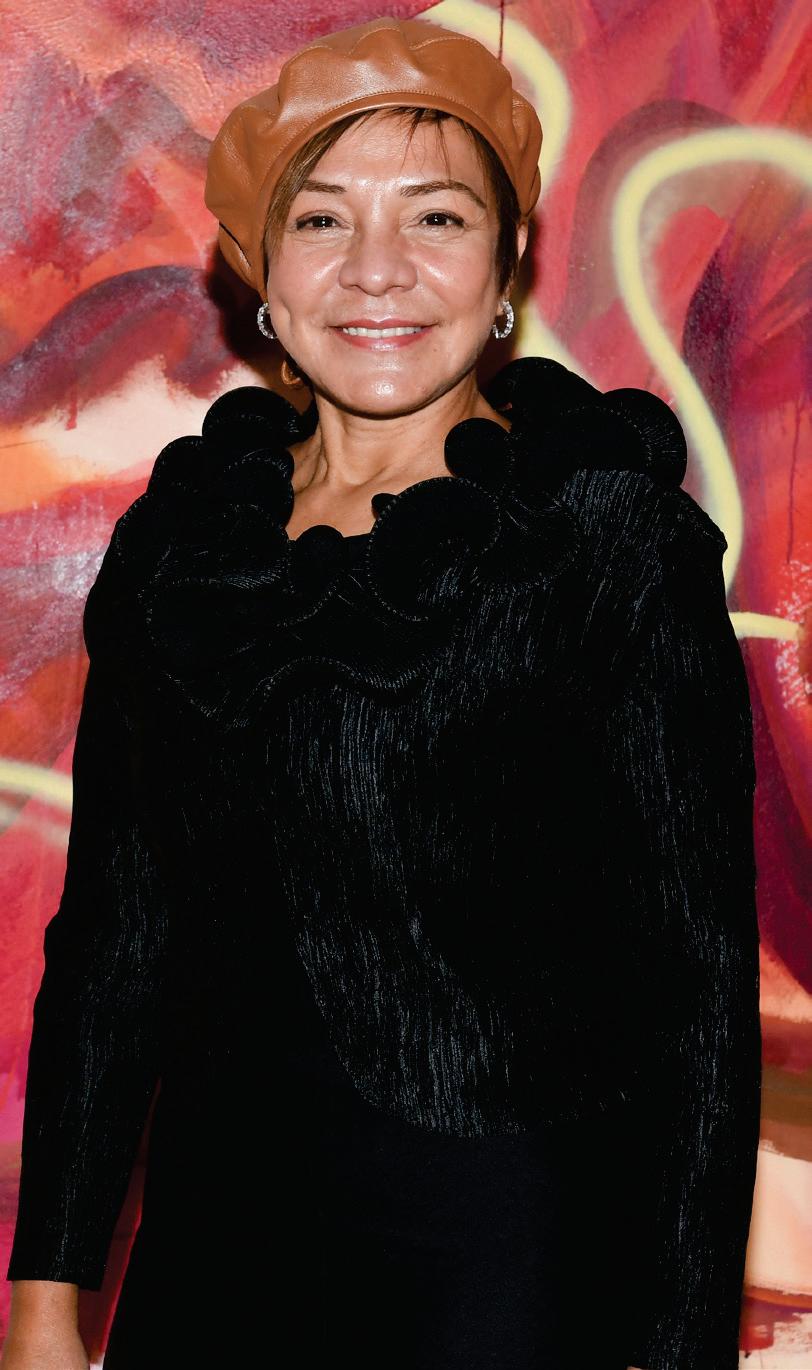
WALL FLOWERS In December, artist Gabriela Gil presented a solo show of paintings from her recent series, “Time and Space,” at 484 Broome Street in SoHo.

Li Jing

Consuelo Vanderbilt Costin



Courtney Bachrach at The Cultivist x Maison Ullens brunch

Katie Holmes at the launch of Overt streetwear at Blue&Cream Thom Browne and Andrew Bolton at the opening of “About Time” at the Met


SIX FEET A-PARTIES Socially distanced dos for “About Time” at the Metropolitan Museum of Art Costume Institute; Watches of Switzerland x Olivia Steele; Boss x Justin Teodoro; The Cultivist x Maison Ullens, and Blue&Cream

Star-Crossed
Astrology columnist Posey Wilt has received complaints about inaccuracies in her January 2020 year-ahead horoscope. She wishes to issue the following corrections

Aries: In hindsight, it was incorrect to advise, “Your ruling planet, Mars, goes retrograde in 2020, but don’t worry! As a warrior fire sign, you always come out on top.” In fact, Mars took you down with it. I regret the error.
Taurus: I promised, “2020 will be a year of unprecedented money-making opportunities,” and it was. After you lost your finance job in April, you pivoted to crafting homemade masks out of fabric scraps to sell on eBay. Unprecedented!
Gemini: “Career-ruling Neptune moves through emotional Pisces this year, which may cause your professional and romantic spheres to overlap in unpredictable ways.” Since Jeffrey Toobin is a Gemini, I’m calling this one as correct.
Cancer: “The stars are literally aligned for you lucky crabs, and the coming year is the perfect time to pursue your dreams,” I wrote. JK. Say hi to your mom for me, the next time you leave her basement.
Leo: “2020 is your time to roar, brave lion!” I’m not retracting this one, since it was technically right, even if the roar was more of a sob/wail combo.
Virgo: “Virgos love to give, but 2020 challenges you to take what’s rightfully yours. Will you be up to the challenge?” Welp, that was a no. Sorry about it.
Libra: “As a Libran you crave balance, and 2020 may finally be the year everything in your life comes into equilibrium.” Since you probably put on an equal ten pounds in each thigh last year, this prediction qualifies as correct.
Scorpio: “This year will require all your charm as you successfully network your way to career advancement.” I neglected to mention it would all be on Zoom, and the specific challenge for Scorpios would be hitting the mute button when you’re venting about how stupid everyone is.
Sagittarius: “Neptune moves through Pisces this year, bold archer, meaning now is your time to shoot for the stars!” If you shot and missed, I’m not responsible.
Capricorn: “2020 is your year, Capricorn, as money-ruling Uranus spends the year in dependable Taurus.” Since most Capricorns are too cynical to read horoscopes, I’m hoping I can just skate by on this one.
Aquarius: “Venus moves retrograde in Gemini from May to June, which may cause minor disruptions in domestic life.” In fact, Venus moved in, took her shoes off, and has been sleeping on your sofa ever since. The best you can hope for in 2021 is that she stops clipping her toenails in the living room.
Pisces: “2020 is your time to shine, as Mercury’s path will bring the emotional calm you need to focus on business success in the year ahead.” What can I say? The polls were wrong.

